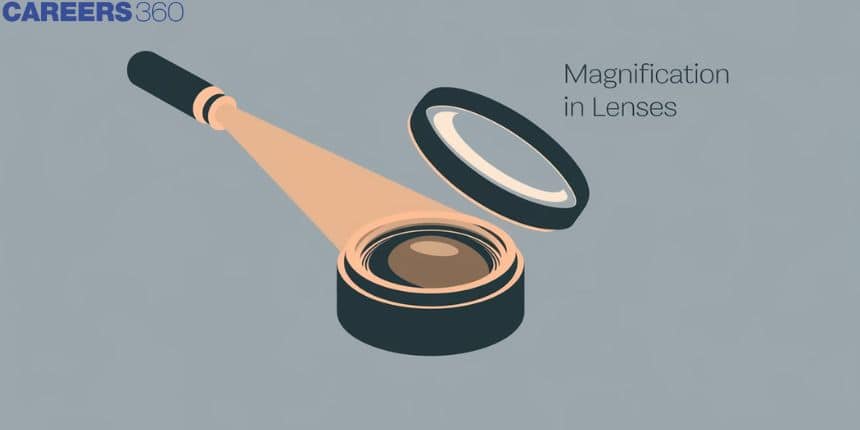Magnification In Lenses
Magnification in lenses is a crucial concept in optics that determines how much larger or smaller an image appears compared to the actual object. It is fundamentally important in various optical devices, including microscopes, telescopes, and eyeglasses, where precise image enlargement or reduction is necessary for clarity and detail. Magnification is calculated based on the lens's focal length and the distances between the object and the image from the lens. In real life, magnification plays a key role in everyday items such as reading glasses, which help individuals with vision impairments see clearly, and cameras, which allow for capturing detailed images of distant subjects. Additionally, magnification is essential in scientific instruments like microscopes, enabling the observation of microscopic organisms and structures that are otherwise invisible to the naked eye. Understanding magnification in lenses enhances our ability to design and use optical tools effectively, improving both practical and scientific applications. In this article, we will cover the magnification, the ray diagram related to it and the formulas.
JEE Main/NEET 2027: Physics Important Formulas for Class 10
NEET 2025: Mock Test Series | Syllabus | High Scoring Topics | PYQs
JEE Main: Study Materials | High Scoring Topics | Preparation Guide
JEE Main: Syllabus | Sample Papers | Mock Tests | PYQs
- Magnification in Lenses
- Solved Example Based on Magnification In Lenses
- Summary

Magnification in Lenses
Magnification in lenses is a fundamental optical concept that measures how much an image is enlarged or reduced compared to the actual size of the object. It is expressed as the ratio of the image size to the object size and is crucial in various applications where detailed and clear image formation is required.
Magnification produced by a lens is defined as the ratio of the size of the image to that of the object.

For the derivation let an object be placed whose height is h and the image height is h'. Let us consider an object is placed on the principal axis with its height h perpendicular to the principal axis as shown in the figure. The first ray passing through the optic centre will go undefeated. The second ray parallel to the principal axis must pass through the focus F' The image is formed where both the light rays intersect. By this, we get an image of height h'. So mathematically, magnification can be written as
Like the mirror equation, we can derive the formula of magnification in terms of the position of the object and image. For this, consider the figure given below -

As the triangle, ABO and A'B'O are similar so we can write that
So,
Recommended Topic Video
Solved Example Based on Magnification In Lenses
Example 1: A telescope has an objective lens of focal length 150 cm and an eyepiece of focal length 5 cm. If a 50 m tall tower at a distance of 1 km is observed through this telescope in a normal setting, the angle formed by the image of the tower is
1)
2)
3)
4)
Solution:
Angular magnification
Hence, the answer is the option (4).
Example 2: A luminous object and a screen are at a fixed distance ’D’ apart. A converging lens for focal length 'f' is placed between the object and the screen. A real image of the object is formed on the screen for two fewer positions separated by a distance ’d’. The ratio of two image sizes for two positions of the lens is:
1)
2)
3)
4)
Solution:
Magnification at two positions of the lens
Hence, the answer is the option (1).
Example 3: A convex lens of focal length f is placed somewhere in between an object and a screen. The distance between the object and the screen is x. If the numerical value of the magnification produced by the lens is m, then the focal length of the lens is :
1)
2)
3)
4)
Solution:
Hence, the answer is the option (1).
Example 4: An object is placed at the focus of a concave lens having focal length f. What is the magnification and distance of the image from the optical centre of the lens?
1)
2)
3) Very high,
4)
Solution:

By lens equation,
Hence, the answer is the option (2).
Example 5: A convex lens produces an image of a real object on a screen with a magnification of
1) 30 cm
2) 60 cm
3) 20 cm
4) 15 cm
Solution:
In the first case, let
Then,
In the second case,
On solving eqs. (i) and (ii), we get
Hence, the answer is the option (3).
Summary
Magnification in lenses is a critical concept in optics, defining how much larger or smaller an image appears compared to the actual object. It is calculated as the ratio of the image size to the object size or the ratio of the image distance to the object distance. Real-life applications of magnification include improving vision with eyeglasses, capturing detailed images with cameras, and observing distant or microscopic objects with telescopes and microscopes. Solved examples illustrate how magnification is used in practical scenarios, such as determining the image angle in telescopes, calculating image size ratios for different lens positions, and finding the lens focal length based on magnification changes.
Also Read
17 Nov'24 10:14 AM
26 Sep'24 11:26 AM
25 Sep'24 06:07 PM
25 Sep'24 05:38 PM
25 Sep'24 05:37 PM
25 Sep'24 05:37 PM
25 Sep'24 03:23 PM
25 Sep'24 03:22 PM
25 Sep'24 03:10 PM
25 Sep'24 03:09 PM

